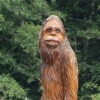I posted this recently on Incorrigible1's similar thread...
Funny how they weren't interested in the tracks.
Physical evidence?
In the scientific and serious popular literature most of the debate has centered on the tracks which, whatever one makes of the sightings or the credibility of witnesses to the animal itself, undeniably exist. Skeptics usually explain these as the spoor of - conventional animals such as snow leopards, foxes, bears-or even wandering Tibetan lamas (who evidently do not mind freezing their feet)-and sometimes claim that melting has distorted their shapes into "yeti" prints. Though by now a virtual article of faith among skeptics, this last notion is a dubious one. Napier, no yeti believer, writes that "there is no real experimental basis for the belief that single footprints can become enlarged and still retain their shapes, or that discrete prints can run (or melt) together to form single large tracks."In any case, some of the tracks are found fresh-in other words, before the elements have had a chance to act on them. Among the more impressive incidents involving tracks is one that happened in 1972 to members of the Arun Valley Wildlife Expedition, a multidisciplinary ecological survey of a deep river valley in far-eastern Nepal where many rare animals and plants live isolated and undisturbed. Its participants, including leader Edward Cronin, a zoologist, were open-minded about the yeti's possible existence and even looked for evidence in the course of their two-year effort, but this was not the main purpose of their endeavor.On the night of December 17, Cronin and expedition physician Howard Emery, along with their Sherpa guides, camped on a depression at 12,000 feet in the ridge of Kongmaa La mountain. The next morning, when Emery awoke and stepped outside, he was startled to find footprints of a bipedal creature which had walked between the two tents sometime in the night. Nine inches long and four and three-quarters wide, perfectly preserved, the tracks showed, Cronin recorded, a "short, broad, opposable hallux, an asymmetrical arrangement of the four remaining toes, and a wide, rounded heel." They looked very much like a yeti print photographed by mountaineer Eric Shipton in 1951.Expedition members followed the prints for some distance. The creature had come up and down the slope to the north, crossed through the camp, and proceeded over the south slope. Then it returned to the top of the ridge. Its tracks disappeared down the south slope in scrub and rock. "The slope was extremely steep," Cronin wrote, "and searching for the prints was arduous and dangerous. We realized that whatever creature had made them was far stronger than any of us."


